Dec 31, 2006 | coins, currency, US Mint
As 2006 comes to a close, we can reflect on what is coming with new US Mint issues. Even with the customer service issues of the last few months because of manufacturing and shipping issues of the San Francisco commemorative and 20th Anniversary American Eagle programs, the Mint is about to launch new programs. These new programs look exciting and I am looking forward to their successes. Here is what we can expect in 2007:
Circulating Currency
Jefferson Nickel will continue using its current design with the end of the Westward Journey Nickel Series.
The 50 State Quarters® Program is entering its second to last year. In 2007, the last five states that entered the union in the 19th Century will be honored: Montana, Washington, Idaho, Wyoming, and Utah. Designs for these coins are available as line-art drawings on the US Mint’s website.
The Presidential $1 Coin Program will begin in 2007 with circulating coins honoring our first four presidents: George Washington, John Adams, Thomas Jefferson, and James Madison. These coins will be made of the same composition as the Sacagawea dollar but include edge lettering, which has not been used since early in the 20th Century. The Sacagawea dollar will continue to be minted, as required by law.
With the addition of the Presidential $1 Coin Program, uncirculated mint and proof sets will be expanded to include the new coins. Although unannounced, it is being projected that the Mint will add additional collectibles surrounding the Presidential $1 Coin Program, like First Day Covers.
For currency collectors, notes are being issued with the signature of Secretary of the Treasury, Henry M. Paulson, Jr. More federal reserve notes will appear with Paulson and Treasurer Anna Escobedo Cabral’s signatures.
Commemorative Coins
As a companion to the Presidential $1 Coin program will begin a First Spouse coin to honor the spouses of presidents in half-ounce 24-karat gold coins. Presidents who served without spouses, will have a commemorative emblematic of the president will be created. The Mint will also produce bronze medals of the coins for collectors.
Celebrating the 400th Anniversary of the Jamestown settlement, the Mint will issue a gold and silver commemorative coins in celebration. Surcharges from the program will go to the Jamestown-Yorktown Foundation of Virginia to support anniversary-related eduction programs and other supporting services, including improving the infrastructure.
Bullion
The American Eagle program continues without interruption. For 2007, the reverse of the American Eagle Platinum Proof coin will be redesigned to honor the Executive Branch of government after 2006 honored the Legislative Branch. After the introduction of burnished uncirculated coins and reverse proof for the gold and silver program’s 20th anniversary, there is no word from the Mint whether they will mint these coins in 2007.
The Mint reported that the most successful program was the American Buffalo Bullion Coin Program. The one-ounce 24-karat gold $50 coin uses the James Earle Fraser Type 1 Buffalo Nickel design to create a beautiful coin. Both collectors and investors made the program a success at the expense of the American Gold Eagle program. These coins will be produced in 2007 with the Mint asking congress to authorize one-half, quarter, and one-tenth ounce issues. If that can be accomplished early in the session of the 110th Congress, the Mint may be able to issue fractional pieces in 2007.
Collects have a lot to look forward to from the Mint. It should be a good numismatic year.
I would like to wish everyone a very Happy, Healthy and prosperous New Year!
Nov 29, 2006 | currency, legal
US District Court for the District of Columbia Judge James Robertson has ruled that the Department of the Treasury is violating Section 504 of the Rehabilitation Act by not designing currency so that it is distinguishable to the visually impaired. In a suit filed by the American Council of the Blind (ACB), Judge Robertson wrote, “It can no longer be successfully argued that a blind person has ‘meaningful access’ to currency if she cannot accurately identify paper money without assistance.”
US currency has been undergoing gradual changes since 1996 to add security features to fight counterfeiters. In the last few years, new notes have included splashes of color to further thwart the new imaging equipment that can create convincing copies of US currency. The next change will come in 2008 with a change to the $5 note.
During this time, no effort was made to provide features that could be used by the visually impaired to distinguish between the different denominations. This prompted the lawsuit from the ACB. In the ruling, Judge Robertson wrote that the ACB proposed several possible changes to including “dimensions varied by denomination, embossed dots, foil, micro-perforations, and raised intaglio printing.”
“Of the more than 180 countries that issue paper currency, only the United States prints bills that are identical in size and color in all their denominations,” Judge Robertson wrote. “More than 100 of the other issuers vary their bills in size according to denomination, and every other issuer includes at least some features that help the visually impaired.”
Judge Robertson noted that the cost to make the changes to the printing process would require less than 5-percent of the expenses generated by the Bureau of Engraving and Printing during the last ten years.
Treasury Department has 30 days to submit a plan to comply with the order.
There has been no comment from the Department of the Treasury. Stay tuned!
Aug 21, 2006 | currency
This past weekend I visited my local branch of the US Postal Service holding one of those salmon-colored forms saying that I had a package that needed to be singed for. The form said that the item was from the US Department of the Treasury. Not thinking about it, I thought that the mail was work-related as in real-life I do some work for Treasury. But when the Postal worker brought out a box, I knew that it was my order for the Texas Coin and Currency Set.
After signing the form, I picked up the box and thought it was a little light. When I persevered in the dash to the Internet to place my order, I ordered five. The box did not feel like it held five sets. After placing the box in my trunk, I used my car key to cut through the packaging tape. In the box were TWO carefully wrapped Texas Coin and Currency Sets. I fumbled through the box looking for an explanation and found a letter from Kevin Brown, Division of Marketing Manager of the Bureau of Engraving and Printing.
The letter blames system failures “… due to the high volume of users trying to access the website.” It further blames “… the Bureau’s Automatic Call Distribution telephone system…” for a “… Treasury wide…” failure that “… also affected other agencies.” This caused BEP to oversell the sets. Although I work with computers for a living, I will not comment on the technology behind this statement except to say I am very disappointed as to how my tax dollars have been misued.
As for the order, in the BEP’s version of “fair,” the powers that be changed the quantities of the orders. With an original limit of 25 sets per order, the reductions were made as follows:
| Original Request |
Reduced Quantity |
| 1–2 sets |
1 set |
| 3–9 sets |
2 sets |
| 10–20 sets |
4 sets |
| 21–25 sets |
5 sets |
When you place an order from BEP via the Internet, they immediately charge your credit card. When you place an order on the telephone, they charge your credit card when the order is placed. Since I was able to place my order over the Internet, my credit card was charged for five sets, which three were credited at the end of July. For a month, Treasury held my money with no intention of filling my order.
It bothers me that BEP charged my credit card prior to shipping the product. If this was done by a commercial vendor I am sure that an oversight group like the Federal Trade Commission would be jumping in with both feet to investigate. I think it is time to write my members of congress to call BEP to task for this fiasco.
Jul 1, 2006 | coins, currency
It was a very tough week here in the Mid-Atlantic Region. We had more rain in four days than we had all year. Then it rained on Wednesday and Thursday to add insult to injury. Days of flooding and horrendous traffic left a lot of us thinking we were having a eight day work week. I had to find something numismatic to soothe my nerves. I found it on Wednesday.
 Although I am not a currency collector, I have been watching the currency market out of curiosity. Over the last few years, that market has been seeing a phenomenal growth in interest, which has lead to record auction prices.
Although I am not a currency collector, I have been watching the currency market out of curiosity. Over the last few years, that market has been seeing a phenomenal growth in interest, which has lead to record auction prices.  While visiting the website for Heritage Auction Galleries, I saw that they sold two notes for $2.1 million! One was a Series 1891 $1000 Treasury Note and the other was a Series 1863 $100 Gold Certificate (images are from the Heritage website). These are very rare notes that were sold to a single collector.
While visiting the website for Heritage Auction Galleries, I saw that they sold two notes for $2.1 million! One was a Series 1891 $1000 Treasury Note and the other was a Series 1863 $100 Gold Certificate (images are from the Heritage website). These are very rare notes that were sold to a single collector.
 While reading about this auction, I remembered that the Bureau of Engraving and Printing (BEP) was selling the Texas Coin and Currency Set that started at noon. This set contains uncirculated Series 2003 $1, $2, $5, and $10 notes with matching low serial numbers that represent the Federal Reserve Bank of Dallas. The set also includes uncirculated Texas State Quarters. BEP announced that only 2,000 sets will be sold at $129.95 each.
While reading about this auction, I remembered that the Bureau of Engraving and Printing (BEP) was selling the Texas Coin and Currency Set that started at noon. This set contains uncirculated Series 2003 $1, $2, $5, and $10 notes with matching low serial numbers that represent the Federal Reserve Bank of Dallas. The set also includes uncirculated Texas State Quarters. BEP announced that only 2,000 sets will be sold at $129.95 each.
Sure the set includes Texas State Quarters, but it extends BEP’s Federal Reserve Evolution Collection (FREC). When the FREC sets were sold last July, it included $20 and $50 notes with matching low serial numbers along with a special book for the Federal Reserve Banks (FRB) of New York, Philadelphia, St. Louis, and San Francisco. Other Evolution sets features FRB of Richmond, Atlanta, and Chicago. All are sold out and command premium prices at the bourse. With the Baltimore Coin and Currency Convention set to begin on July 14, I am interested to see what the dealers will be selling these set for.
As a numismatist whose collection consists mainly of coins, finding a new collectible that includes coins and adds a little diversity to the collection is a lot of fun. But to find a hot collectible with a limited distribution that has quickly appreciated within days of a sell-out, buying a few extra is a nice investment. So I bought five sets with remorse that I could not afford to purchase more!
Apr 8, 2006 | BEP, coins, currency
Money has always been a fascination because of their design and the history they reveal. It is interesting to look at a series of the same denomination and learn the history behind the designs. I had the chance to do that when my bank’s ATM gave me three generations of $20 Federal Reserve Notes (FRN). Although I am not a bank note collector, I find their images and devices interesting.
 First, I found is the Series 1990 note with the signature of Treasury Secretary Nicholas F. Brady and Catalina Vasquez Villalpando, the Treasurer of the United States. Both Brady and Villalpando were appointed by President George H. W. Bush and served until the end of his term. Brady also served for six months under President Ronald W. Reagan.
First, I found is the Series 1990 note with the signature of Treasury Secretary Nicholas F. Brady and Catalina Vasquez Villalpando, the Treasurer of the United States. Both Brady and Villalpando were appointed by President George H. W. Bush and served until the end of his term. Brady also served for six months under President Ronald W. Reagan.
The second is a Series 2001 note with the signatures of Treasury Secretary Paul M. O’Neill and Treasurer Rosario Marin. They were appointed by President George W. Bush during his first term. The third note is from Series 2004 with Marin’s signature along with Treasury Secretary John W. Snow, who succeeded O’Neill.
 My first impression was the differences in design. The $20 FRN was first designed in the 1920s and was an evolution of earlier designs. It has ornate and fine engraving with a green hue. The fine engraving has been a staple of bank notes since their inception as a means to prevent counterfeiting. The “green back” was used to prevent copying using new photographic technologies which had a difficult time reproducing the green color. Today, the green color remains out of tradition considering modern imaging capabilities.
My first impression was the differences in design. The $20 FRN was first designed in the 1920s and was an evolution of earlier designs. It has ornate and fine engraving with a green hue. The fine engraving has been a staple of bank notes since their inception as a means to prevent counterfeiting. The “green back” was used to prevent copying using new photographic technologies which had a difficult time reproducing the green color. Today, the green color remains out of tradition considering modern imaging capabilities.
The newer notes do not have a lot of fine engraving. The same portrait of President Andrew Jackson is used but was enlarged on the newer notes with the border around the portrait removed on the Series 2004 notes. Another difference is the addition of color with a darker green hue and peach on the front adds a new dimension I am not sure I like.
Although an engraving of the White House remain on the reverse, the older note uses an image taking from the south lawn from the ellipse. The new notes show the White House from the north lawn that could be seen from Pennsylvania Avenue more centered rather than filling the entire reverse. As part of the Bureau Engraving and Printing’s (BEP) program to include better security features, they have left the sides blank so the watermark image and security thread can be easily seen.
I like the front of the latest note, but I don’t like the color. I also miss the indication of the Federal Reserve System Bank for which the notes were printed. It is like the mint mark for the FRN. I always found it interesting finding notes from different areas. I like the south lawn portrait better than the one from the north lawn. I am disappointed with the starkness of the reverse. I am not sure that BEP can change this given the nature of the security features.
Finally, the attempt to colorize the notes is not working. It looks cheesy. If BEP colorizes the note, it should be more than just a gradient on the background. Many countries use color in their bank notes as part of the devices, not just to splash some color around to say “look at the color.” I think BEP can do better.
Mar 12, 2006 | coins, currency, history, medals, silver
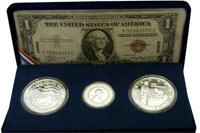 In this time of uncertainty, I feel that we Americans need to remember those who have given their lives in defense of this country. This is not a political statement on the current Middle East situation, but an appreciate of those with their boots on the ground who risk their lives daily. As part of that, my wife and I visited the U.S.S. Arizona (BB-39) Memorial at Pearl Harbor during our trip to Hawaii. Unfortunately, rain prevented us from visiting the U.S.S. Missouri (BB-63) Memorial.
In this time of uncertainty, I feel that we Americans need to remember those who have given their lives in defense of this country. This is not a political statement on the current Middle East situation, but an appreciate of those with their boots on the ground who risk their lives daily. As part of that, my wife and I visited the U.S.S. Arizona (BB-39) Memorial at Pearl Harbor during our trip to Hawaii. Unfortunately, rain prevented us from visiting the U.S.S. Missouri (BB-63) Memorial.
In front of the gift shop that is inside the Visitors Center was a table with gentleman selling Pearl Harbor commemorative medals and sets produced by the Honolulu Mint. I was very intrigued by the items and gravitated to the commemorative set that contains two .999 Silver, 1 Troy Ounce medals, an uncirculated 1943 Steel Lincoln Cent, and a Series 1935A Hawaii issue Silver Certificate. Even though I am not a commemorative collector, I do tend to buy numismatic items from my personal experiences. While standing in the Memorial, and with my wife’s urging, I could not pass up buying this set.
-
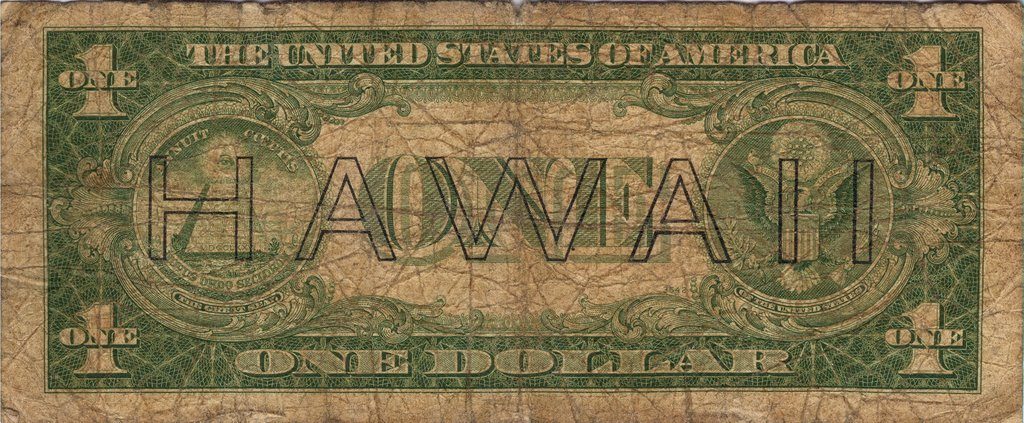
-
Series 1935A Silver Certificate with “HAWAII” Overprint Reverse
The set includes a medal commemorating the 65th Anniversary of the Japanese bombing of Pearl Harbor. The obverse shows the U.S.S. Arizona and the anniversary date. The reverse shows an arial view of the memorial with the outline of the sunken ship in the water. On the image are the words “Honoring all those who made the ultimate sacrifice on Dec. 7, 1941.”
-
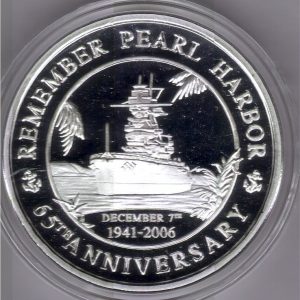
-
Obverse of the Pearl Harbor 65th Anniversary silver medal
-
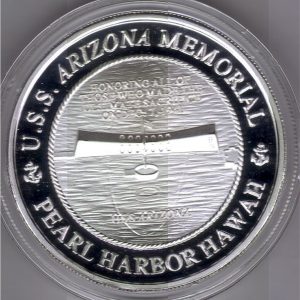
-
Reverse of the Pearl Harbor 65th Anniversary silver medal
The other medal commemorates the Japanese surrender aboard the U.S.S. Missouri. It was prophetic that the articles of surrender were signed on her deck. The obverse of this medal recreates the signing of the document by General Yoshijiro Umezu, Chief of the Army General Staff, with Lieutenant General Richard K. Sutherland standing across the table. The reverse has the inscription on the deck of the Missouri where the articles were signed.
-
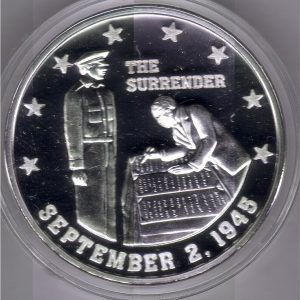
-
Obverse of the Japanese Surrender Silver Medal
-
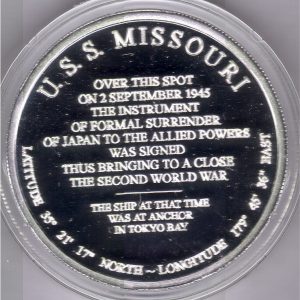
-
Reverse of the Japanese Surrender Silver Medal
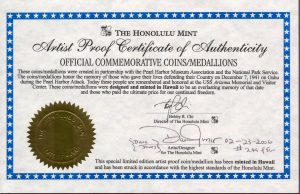
Personally autographed COA from the Honolulu Mint
Although everyone should visit the U.S.S. Arizona Memorial and the rest of Pearl Harbor, I know it is not a trip that every can take. So if you are interested in this collectible and other medals honoring those who served and gave the ultimate sacrifice, you can visit the Honolulu Mint’s website or the U.S.S. Arizona Memorial Bookstore. Portions of the proceeds benefit the Memorial.
Dec 7, 2005 | coins, currency
The National Numismatic Collection of the Smithsonian Institution is the world’s largest numismatic collections. Up until it closed in August 2004, the collection was located in the National Museum of American History on The National Mall in Washington, DC. The collection has over 450,000 coins, medals, and decorations and over 1 million pieces of paper money. While pieces have been used for education programs and have appeared in other displays, there was no numismatic collection on display since.
Starting on December 8, 2005, the Museum of American History will exhibit “56 rare and historically significant artifacts from the Museum’s National Numismatic Collection—more than half of which have never been on view or have not been displayed for many years. Coins, bills, medals and captivating oddities—such as pattern designs, fantasy coins and homemade clam shell money from the Great Depression—will be on display.” This is a rare opportunity to see coins like a 1913 Liberty Head nickel, one of five known to exist and a 1907 Saint-Gaudens ultra high relief Double Eagle—from Augustus Saint-Gaudens‘ original design as commissioned by President Theodore Roosevelt.
The museum will have a companion website that will also debut with the opening. You can visit the site at http://americanhistory.si.edu/coins. It is a good reason to come and visit your nation’s capital.
Nov 20, 2005 | currency
During my run around the Internet, I followed some links to a libertydollarbill.com, a site promoted out of Liberty Middle School in Ashland, Virginia (a suburb of Richmond). The program, sponsored by teacher named Randy Wright, has been lobbying congress since 1999 for the Bureau of Engraving and Printing (BEP) to change the back of the $1 bill to be printed an abridged version of the US Constitution. The abridging would include the entire preamble, the names of each Act, and the title of each amendment. The Christian Science Monitor and Ralph Nader have endorsed the bill.
According to their website, the claim is that not enough people know and understand the Constitution that governs their lives. By putting a representation of the consititution on the most common piece of paper currency, the concept would be available to everyone. It is an interesting concept that may be looking at the wrong way to educate the masses.
First, I am amongst a growing number of people that believes that the $1 and $2 bills should be discontinued in favor of coinage (I will explain why in a future entry). But if congress does not eliminate this currency (which seems the likely scenario), then just a one-line summary of the constitution is really not enough. What about having a series of currency issues with either the text or summary of each Article and Amendment? In the same spirit as the 50 State Quarter® program from the US Mint, not only would the currency serve as a learning tool but would generate seigniorage for the BEP by creating new, circulating collectibles.
The US currency has really gotten stale in its designs. Even the recent upgrades can only be classified as “putting lipstick on a pig.” Maybe this would be a good idea if it can bring new designs to the currency.












